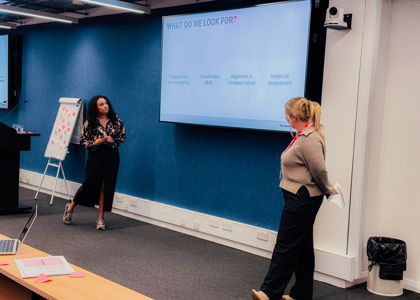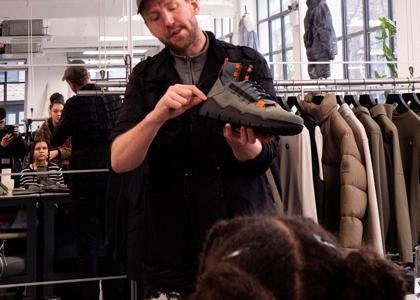
Get real-world insights from leading fashion brands. Explore how our BA (Hons) Marketing & Communication for Fashion students learned directly from Ann Summers team in an exclusive masterclass.
10th April 2025
 Back
Back
Date 1st March 2023
Artificial intelligence is fast evolving and already has many uses across lots of different industries, including the fashion industry. From designing clothes to predicting consumer preferences, AI is transforming the way fashion is produced, marketed, and consumed. With its ability to analyse vast amounts of data and learn from patterns, AI is opening up new possibilities for designers, retailers, and consumers alike. Read our guide and discover the exciting ways AI is used in the fashion industry.
Artificial intelligence (AI) refers to computers and machines that are capable of mimicking the problem-solving and decision-making capabilities of humans. AI is designed to perform tasks that typically require human intelligence, such as recognising patterns, making decisions, and understanding natural language.
There are several types of AI systems, but one of the most common is machine learning, which involves training a machine learning algorithm on a large dataset of examples so that it can learn to make predictions or decisions based on new input data. As the algorithm learns from the errors it makes on the training data, it adjusts its internal parameters to improve its predictions.
There are four main types of Artificial Intelligence, including:
Reactive AI: Reactive AI is a type of AI that can react to new situations and learn from them, without having been explicitly programmed to do so. Examples of reactive AI within the fashion industry include visual search, personalised product recommendations and price optimisation.
Limited Memory AI: Limited memory AI systems are those that can learn from experience and use this knowledge to improve their performance in the future. Examples of limited memory AI within the fashion industry include customer service chat bots, trend forecasting and inventory management.
Theory of Mind AI: Theory of mind AI, which is the most advanced type of AI, has the ability to understand human emotions and motivations and respond in a human-like manner. This type of AI is not widely used in the fashion industry, but there are some emerging applications, such as virtual styling assistants and interactive shopping experiences.
Self Aware AI: Self-aware AI, also known as reflective AI, is a more advanced form of artificial intelligence that is capable of not only understanding and interpreting data, but also reflecting on its own internal processes and improving its performance over time. This type of AI does not currently exist.
Artificial Intelligence is already being used in various ways across the fashion industry to enhance processes for customers and increase the speed of manufacturing and business operations. Some of the ways AI is being used in the fashion industry are:
Overall, AI is playing an increasingly important role in the fashion industry, helping companies streamline processes, reduce costs, and improve the customer experience.

Artificial intelligence has advanced capabilities when it comes to retail data analytics, which makes it incredibly useful in the fashion industry for forecasting trends and sales. This information can be used by fashion buyers to better predict customer behaviour and reduce the number of unsold items each season.
AI has the power to analyse vast amounts of data from various sources such as social media, the runway, fashion blogs, sales data and other trend forecasting tools. This information is then combined with past product performance and customer behaviour data to establish the optimum collection of products that will best resonate with the retailer's target audience.
Not only can AI inform buyers about which products are performing well or will perform well, but they can also provide insight on the specific components of the garments such as colour, prints, sleeves, necklines and more. In addition, it has the capability to provide real time data allowing buying teams to take on a more proactive approach that will help them stay relevant and ahead of the competition.
By using AI tools to conduct trend forecasting for elements such as colour, fabric, patterns and cut as well as analysing past and future performance indicators, designers can also use AI to create new product designs. This allows designers to quickly and accurately generate trend led designs for production that are complete with sewing patterns. Designers can then make adjustments to the designs as they see fit before signing off the final look.
Artificial intelligence can also be used to streamline much of the production process by creating digital samples and conducting fit tests. In addition, it also has the capability to accurately automate fabric quality control, pattern inspections, colour matching and defect detection. This greatly cuts down the time it takes to design and test products before manufacturing.
Though artificial intelligence already has many uses within fashion design, the technology is continuously being advanced. For example, a greater focus on sustainability means that AI could be used to find alternative materials that won’t harm the environment.
Artificial intelligence has a huge range of uses for online stylists and visual merchandisers. It can analyse customer data and preferences to provide personalised recommendations to online shoppers and provide styling tips. By showing users products that match their preferences, you can improve the overall online experience, increase customer satisfaction and ultimately increase sales and revenue.
AI styling tools and platforms can be used by retailers to build, track and manage customer styling profiles. Based on the information the user provides, AI can create personalised recommendations for each person, speeding up the virtual styling process. These outfits can then be added to the shopping basket, shared via email or delivered straight to the customer.
AI can also be used to create personalised product recommendations and bespoke pages based on different trends, customer segments and geographical locations. This can be really useful when creating custom pages for paid advertising purposes as it drastically speeds up the process of manual product presentation and reduces cost.
One of the main benefits of artificial intelligence in the fashion industry is that it can quickly and easily understand complex data and provide an in-depth analysis. This is incredibly useful for merchandisers who need to manage product inventory, manage pricing and costs and conduct competitor analysis.
AI can vastly improve all aspects of stock control and management by minimising stock shortages and reducing overstocking. Retailers can use AI to assess when and where products should be placed based on location and seasonality. This allows them to be ahead of the curve in terms of where supply and demand is, helping to reduce surplus stock and reduce waste.
Lastly, retailers can use AI to monitor competitor prices to determine the most effective product and pricing strategy in order to gain the greatest ROI and have the most competitive prices. As a result, they can identify the best time to keep prices low while retaining minimal margins and when to slightly increase prices to maximise profits.

AI has many uses within fashion ecommerce, especially when it comes to product recommendations. From suggesting similar products for out of stock items to providing fit recommendations based on where customers currently shop, the possibilities are endless.
Complete the look recommendations is just one of the ways in which AI can help online retailers increase the average order value. When buying products, customers are often inspired by the outfit that has been styled in the image. AI technology can recognise the items from the images and include the products in the complete the look section for users to buy, thus increasing the average order value.
Personalised sizing recommendations is now one of the most commonly seen uses of AI technology for online retail brands. If customers are unsure of what size to order, they can complete a short and quick fit assistant survey. The fit assistant AI takes into consideration the customers height, weight, body shape and existing clothing along with other customers with similar details to provide the most accurate sizing recommendations. This helps reduce the number of returns, which is a great cost saving for retailers.
AI product search and discovery is incredibly intuitive and you’ve probably used it multiple times without even realising. From taking a photo using Google Lens to find an item online to using Pinterest to find products that match items from the outfit in a blogger's photo, this type of AI functionality is something that is widely used by retailers.
Images are hugely important within the fashion industry. They help retailers portray their brand image and also allow customers to see the product offering. AI technology has the ability to understand these images and when customers search for specific products on a website retailers can use this information to inspire them with other products that match their taste based on the products they have interacted with.
This technology can also be used to create personalised product rankings. AI identifies what each customer is most likely to want and buy from a retailer’s inventory and then displays those products in that order. Personalised product ranking enables the best customer to product matching and ensures the right products are seen by the right customers at the right time. For example, ASOS ranks products in its ‘new in’ section based on recommendations rather than newest first.
Customer service is one of the most important components of any fashion business and AI chat bots allow retailers to have 24/7 one to one contact with their customers before, during and after a sale. They can be integrated throughout the whole user journey allowing brands to keep customers aware of the latest offers, products and new content. By using the platforms that their customers are already familiar with such as Facebook, Instagram and Whatsapp they can make it easier than ever to shop online.
Chatbots can also be tailored to match the brand’s identity and tone of voice making it easier to spread brand awareness and keep their customer service consistent. By utilising a customer relationship management platform (CRM) they can use chatbots to make product recommendations, arrange exchange and returns, answer customer enquiries and offer styling advice.
Furthermore, chatbots can also interpret conversation flow and can assess when the customer needs to be connected to a human assistant. This approach significantly reduces the volume of enquiries for customer service teams while still allowing a human touch where needed.

Though AI is often a tool that is considered to be used mostly online, its benefits can also be transferred across to instore retail settings. This helps to optimise the shop floor and allows retailers to tie in a customer’s online journey into the physical store.
AI technology can help sales assistants find and recommend similar items without having to go through all available inventory if a product goes out of stock in a customer's size or colour. As a result, they will be able to offer excellent customer service and a positive shopping experience to more customers. It also helps to reduce the number of missed sales opportunities and helps retail staff meet sales targets.
In addition to finding and locating stock that a customer has asked for, AI can also empower sales assistants to provide customers with expert outfit styling advice for each product in stock. This helps retailers provide a more bespoke customer service experience, whilst also increasing the average basket value.
Artificial intelligence is incredibly useful for retail brands that have a digital and physical store presence as it allows them to seamlessly connect with their customers and provide the same level of service and experience at each touch point. A great example of this is Zara’s buy online and pick up in store service.
Incorporating all digital and physical retail data into one platform using customer profiles means that a loyal customer visiting a physical store for the first time or at a different location can expect a fully customised service.
Sales assistants can easily access a customer’s profile and immediately know their style, likes, dislikes and purchase behaviour to delight the customer with a bespoke experience every time.
Retailers can now integrate AI technology into a number of customer touch points on the shop floor using smart mirror technology. From interactive boards that can be used for visual merchandising purposes to smart displays that can offer virtual try-ons and styling advice, AI digital displays are rapidly changing how customers can shop in store.
Smart mirrors essentially act as an extension of the retail assistant team and can be used to discover products, find the customers size and suggest outfits to compliment the items they are looking for. This functionality means that customers can always gain the help they need even when staff are busy helping other customers.
They can also be used as interactive installations to help inspire and inform customers as well as act as a brand storytelling tool. The displays can be used in shop windows to increase footfall and repeat visits or used to raise awareness of a brand's ethical practices and brand values.

AI has many benefits within the fashion industry and its ability to use customer data to create marketing and promotional campaigns that are personalised to each customer makes it an incredibly powerful marketing tool. It can accurately predict future purchase behaviour based on past purchases, browsing behaviour and individual customer preferences.
AI can use this information to increase customer retention and repeat purchases by creating personalised campaigns for each customer. For example, AI can analyse a customer's past purchases and provide ‘complete the look’ product recommendations to encourage users to return to the website or store.
Furthermore, artificial intelligence can analyse data about customers demographics, interests, and online behaviour to identify which ads are most likely to be of interest to them. This helps improve the overall effectiveness of advertising campaigns by ensuring that the ads are seen by the right people at the right time.
Another method retailers can use to increase customer retention and repeat purchases is through loyalty programs. Loyalty programs encourage customers to continue to shop with a brand by offering discounts, rewards, points and other special incentives. However the discounts and rewards that customers receive can now be tailored to each individual.
AI technology can take into consideration a customer's past purchases looking at what products they have bought and what brands they tend to favour and will then generate discounts and offers based on their behaviour.
The discounts can then be shared with each customer via text, email or post and they can typically be used online and in store. A great example of this is the Boots Advantage card. Customers can earn points to later spend in store and will receive personalised promotions based on their purchases.
Artificial intelligence is widely used across a number of industries to create automated content. The technology is now so advanced that it can write content using natural human language, be instructed to use a specific tone of voice and can conduct competitor research within seconds.
Retailers can use this type of AI to create content for a wide range of marketing activities including writing product descriptions, writing category content, proofreading and content ideation. Using AI to generate short form content frees up copywriters to work on more creative projects and strategy planning.
There are many benefits to utilising AI for content creation within the fashion industry. Not only is it incredibly cost effective for retailers, particularly those with limited resources but it also enables brands to create data driven marketing content that will convert and is always on brand.
In summary, Artificial Intelligence has a vast range of uses in the fashion industry, from forecasting trends and sales to personalised recommendations and improved inventory management. With the continuous advancement of technology, the potential for AI in the fashion industry is limitless.
Do you want to be at the forefront of the ever evolving fashion industry? Why not study at the Fashion Retail Academy.
The FRA is a unique, industry-led college that was founded by fashion giants. We offer specialist fashion courses with unparalleled industry involvement and ensure that all of our students graduate with the skills and brand contacts they need to successfully start a career in fashion.
We offer a range of courses, including Level 2, Level 3 and Level 4 qualifications, as well as online and undergraduate courses, and apprenticeships.
If you have any more questions about any of the courses on offer at The Fashion Retail Academy, send us an email to info@fra.ac.uk - we’d love to hear from you!

Get real-world insights from leading fashion brands. Explore how our BA (Hons) Marketing & Communication for Fashion students learned directly from Ann Summers team in an exclusive masterclass.
10th April 2025

Get inspired by Chloe Dean, the new face of the FRA. Follow her journey as she shares tips, advice and insights into student life at the FRA. Start your fashion career with us today - apply now!
3rd April 2025

Ready to gain real-world experience and learn from industry experts like Christopher Raeburn?
Explore our courses and take the first step towards your future in fashion. Apply today!
28th March 2025